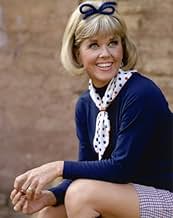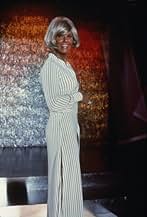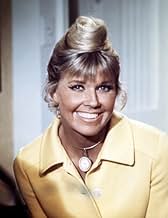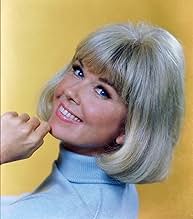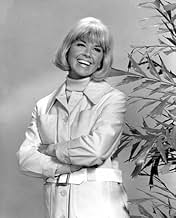Aggiungi una trama nella tua linguaAfter spending most of her life in big cities, widow Doris Martin decides to move back to the family ranch.After spending most of her life in big cities, widow Doris Martin decides to move back to the family ranch.After spending most of her life in big cities, widow Doris Martin decides to move back to the family ranch.
- Premi
- 2 candidature totali
Sfoglia gli episodi
Recensioni in evidenza
When I was a kid this was my first exposure to Doris Day. I was only two when this show first aired and I used to watch it every week. However, it was fairly confusing due to the fact that it changed situations almost every season. In the first season she was the typical widowed mom raising her two kids in an almost carbon copy of "Green Acres", but without the surrealism of that show. In the second season we see her become a writer for a magazine, which she would remain, with slight variations for the next few years. However, in the final season, the show pretty much becomes another version of "Mary Tyler Moore" with her now playing a single girl and without the kids that she had for the first few years. However, despite these changes Doris Day retained the charm and grace that made her one of the most popular stars in television.
Also, one thing that is quite ironic is the fact that this show was set in San Francisco, which was the same locale as her former co-star, and close friend, Rock Hudson's series "McMillan and Wife". That fact could have led to all sorts of guest star possibilities.
Also, one thing that is quite ironic is the fact that this show was set in San Francisco, which was the same locale as her former co-star, and close friend, Rock Hudson's series "McMillan and Wife". That fact could have led to all sorts of guest star possibilities.
How this show lasted five years is amazing considering each year the show was about something else. Her trademark theme song said it each week: 'What ever will be will be!' The show aired between 1968 and 1973, a time when women's roles changed in society and on television. "The Doris Day Show" reflected these changes beginning with Doris as a "modern housewife:" a widowed mother of two living in the country, and evolved into a pre-Mary Richards role model for single women in the work place (the first ever on television!) Because each year brought a different look (and different cast) to the show, it is difficult to sell in syndication but perhaps Nick-at-Night which prides itself in the evolution of such shows will have fun with it some day. (My suggestion: Do one of those five nights a week summers where Monday has the first year, Tuesday has the second year, and so forth...each year really was an entity unto itself.) The bottom line is that it features America's sweetheart Doris Day and that's really all that it needed. What ever will be will be.
THE DORIS DAY SHOW (CBS, 1968-73), stars Doris Day in her only weekly comedy series. An actress whose screen career lasted twenty years (1948-1968), ranging from musicals, comedies and heavy dramas, at this point. By 1968, her career was virtually over, until finding herself working for the little screen called television.
THE DORIS DAY SHOW, premiering on CBS in September of 1968, opens with her signature theme song, "Que Sera Sera." The first season finds the widowed Doris Martin (Doris Day), living with her white haired, bearded father, Buck Webb (Denver Pyle) on the family ranch with her two blond-haired sons, Billy (Philip Brown) and Toby (Todd Starke), the little guy with a buck tooth. With similarities to the recent TV show, GREEN ACRES, Doris is a city girl now back on the farm. Supporting her father is the hired hand country boy, LeRoy B. Simpson (James Hampton). There's also a housekeeper, Aggie (Fran Ryan), and later Juanita (Naomi Stevens). The first season followed the tradition of other sit-coms of that time, sugar sweetness with country humor, never rising above the number one TV show of that time, THE ANDY GRIFFITH SHOW. The second season found Doris Martin still living on the farm, but now commuting to San Francisco and working as a secretary for Mr. Nicholson (MacLean Stevenson) at TODAY'S WORLD MAGAZINE. Also in support is Myrna Gibbons (Rose Marie, best known as Sally Rogers in THE DICK VAN DYKE SHOW). Rose Marie became an added plus in the show, although her character, a single woman always looking for the Mr. Right, was actually no different from her role on Van Dyke's show. Myrna and Doris were given a second banana character in the carnation of Ron Harvey (Paul Smith), a bachelor co-worker on the trail of beautiful female companionship. With this change, the show was slowly finding itself. For season three, Doris moves from her father's farm, taking her the boys and their sheepdog, Lord Nelson, to an apartment in San Francisco over an Italian restaurant run by Angie and Louie Palucci (Kaye Ballard and Bernie Kopell). Doris continues to work at TODAY'S WORLD MAGAZINE. Denver Pyle, no longer a series regular, appeared occasionally mostly in guest spots. While still working woman, Doris manages to find quality time with her boys. Up to this time, THE DORIS DAY SHOW improved, showing both humor and heart to the character and plots, but it was still trying to find itself.
As a youngster growing up during this period, I always enjoyed programs like this, especially whenever they included kids. The big change came with seasons four and five when Mrs. Doris Martin, still working at TODAY'S WORLD MAGAZINE and living in the same apartment on top of Palucci's Italian Restaurant, becomes Miss Doris Martin, a bachelor girl. The format shifted gears, eliminating the Martin boys, their dog, and contradicting everything from the previous seasons. Regardless, the show finally found itself. Of course there were occasional characters reprising their roles from the previous seasons, namely Kaye Ballard, Van Johnson and Billy DeWolfe (hilarious as Mr. Jarvis), so obviously this is the same character and same show with different format. Another difference, being true to life, is Doris now working as a staff writer for a new boss, Cy Bennett (the mustached John Dehner), supported by new co-worker pal, Jackie (Jackie Joseph). Changing her employer from a handsome and easy-going man to a stuffy middle-aged miser was a fine change, which found Doris at wits with her stingy boss. The final two seasons is the format that lasted the longest.
This new format would have worked had Doris Martin remained what she has been previously. Having the boys mentioned as being sent away to boarding school would have explained the emptiness of her apartment. It's surprising it wasn't renamed THE NEW DORIS DAY SHOW. What did happen was Doris Day succeeded in making this dramatic change work. For most, the working girl/family episodes from the second and third seasons are the best. The worst episodes are those with Doris as the only model in the annual fashion shows. A musical show showcasing Doris's fine singing voice would have been preferable, almost as nostalgic as the two Christmas episodes (1970 and 1971) which made them so enjoyable. One episode I remember most but like the least is "Young Love" from Season Three, where Doris appears in the opening segment, comforting a troubled teen named April (played by Meredith Baxter), who tells her story via flashback, taking up the entire episode. In Seasons Four and Five, Doris Martin found a romantic love interest, a middle-aged doctor, played by silver-haired Peter Lawford.
An episode, which I feel might be the one closest to Doris Day's heart, is the one in which she goes on trial for releasing a group of dogs locked in an automobile parked in the hot sun with shut windows. After being taken to court by the owner, she, of course, gets acquitted following her plea in the courtroom for the safety of dogs and other creatures, and her willingness to do what she did again even if it meant serving jail time. No doubt this could be Doris Day's personal favorite since it's more Doris Martin being Doris Day, an animal rights activist.
All episodes of THE DORIS DAY SHOW were produced on film and in color. Interestingly, seldom revived in syndication. Unseen on cable since the 1980s, all 128 episodes are currently available on DVD.
THE DORIS DAY SHOW, premiering on CBS in September of 1968, opens with her signature theme song, "Que Sera Sera." The first season finds the widowed Doris Martin (Doris Day), living with her white haired, bearded father, Buck Webb (Denver Pyle) on the family ranch with her two blond-haired sons, Billy (Philip Brown) and Toby (Todd Starke), the little guy with a buck tooth. With similarities to the recent TV show, GREEN ACRES, Doris is a city girl now back on the farm. Supporting her father is the hired hand country boy, LeRoy B. Simpson (James Hampton). There's also a housekeeper, Aggie (Fran Ryan), and later Juanita (Naomi Stevens). The first season followed the tradition of other sit-coms of that time, sugar sweetness with country humor, never rising above the number one TV show of that time, THE ANDY GRIFFITH SHOW. The second season found Doris Martin still living on the farm, but now commuting to San Francisco and working as a secretary for Mr. Nicholson (MacLean Stevenson) at TODAY'S WORLD MAGAZINE. Also in support is Myrna Gibbons (Rose Marie, best known as Sally Rogers in THE DICK VAN DYKE SHOW). Rose Marie became an added plus in the show, although her character, a single woman always looking for the Mr. Right, was actually no different from her role on Van Dyke's show. Myrna and Doris were given a second banana character in the carnation of Ron Harvey (Paul Smith), a bachelor co-worker on the trail of beautiful female companionship. With this change, the show was slowly finding itself. For season three, Doris moves from her father's farm, taking her the boys and their sheepdog, Lord Nelson, to an apartment in San Francisco over an Italian restaurant run by Angie and Louie Palucci (Kaye Ballard and Bernie Kopell). Doris continues to work at TODAY'S WORLD MAGAZINE. Denver Pyle, no longer a series regular, appeared occasionally mostly in guest spots. While still working woman, Doris manages to find quality time with her boys. Up to this time, THE DORIS DAY SHOW improved, showing both humor and heart to the character and plots, but it was still trying to find itself.
As a youngster growing up during this period, I always enjoyed programs like this, especially whenever they included kids. The big change came with seasons four and five when Mrs. Doris Martin, still working at TODAY'S WORLD MAGAZINE and living in the same apartment on top of Palucci's Italian Restaurant, becomes Miss Doris Martin, a bachelor girl. The format shifted gears, eliminating the Martin boys, their dog, and contradicting everything from the previous seasons. Regardless, the show finally found itself. Of course there were occasional characters reprising their roles from the previous seasons, namely Kaye Ballard, Van Johnson and Billy DeWolfe (hilarious as Mr. Jarvis), so obviously this is the same character and same show with different format. Another difference, being true to life, is Doris now working as a staff writer for a new boss, Cy Bennett (the mustached John Dehner), supported by new co-worker pal, Jackie (Jackie Joseph). Changing her employer from a handsome and easy-going man to a stuffy middle-aged miser was a fine change, which found Doris at wits with her stingy boss. The final two seasons is the format that lasted the longest.
This new format would have worked had Doris Martin remained what she has been previously. Having the boys mentioned as being sent away to boarding school would have explained the emptiness of her apartment. It's surprising it wasn't renamed THE NEW DORIS DAY SHOW. What did happen was Doris Day succeeded in making this dramatic change work. For most, the working girl/family episodes from the second and third seasons are the best. The worst episodes are those with Doris as the only model in the annual fashion shows. A musical show showcasing Doris's fine singing voice would have been preferable, almost as nostalgic as the two Christmas episodes (1970 and 1971) which made them so enjoyable. One episode I remember most but like the least is "Young Love" from Season Three, where Doris appears in the opening segment, comforting a troubled teen named April (played by Meredith Baxter), who tells her story via flashback, taking up the entire episode. In Seasons Four and Five, Doris Martin found a romantic love interest, a middle-aged doctor, played by silver-haired Peter Lawford.
An episode, which I feel might be the one closest to Doris Day's heart, is the one in which she goes on trial for releasing a group of dogs locked in an automobile parked in the hot sun with shut windows. After being taken to court by the owner, she, of course, gets acquitted following her plea in the courtroom for the safety of dogs and other creatures, and her willingness to do what she did again even if it meant serving jail time. No doubt this could be Doris Day's personal favorite since it's more Doris Martin being Doris Day, an animal rights activist.
All episodes of THE DORIS DAY SHOW were produced on film and in color. Interestingly, seldom revived in syndication. Unseen on cable since the 1980s, all 128 episodes are currently available on DVD.
"Raysond" wrote this in his/her review: "due to low ratings and a sorry time slot) to let it go and from there "The Doris Day Show" was canceled by CBS. Also during this time the career of singer/actress/producer Doris Day was over and to this day in 1973 officially retired from the entertainment industry where she is living peacefully somewhere in her private estate in Hollywood."
Nothing could be far from the truth. Yes, CBS dealt Doris Day a "Ft. Knox Hand" (that's what VARIETY called it) to Miss Day for her to do a TV series. But, unlike what was reported by Raysond, the series was consistently in the Top 20 it's entire run. Doris Day called it quits with CBS. She had never wanted to do television in the first place: her husband secretly signed her to the CBS contract without her permission. He died, and as Day has said, "I was delivered to CBS." From what I have read, CBS wanted Doris to re-sign and continue the show, but she declined. She did, however, live up to her contract and did the two musical specials that her late husband promised.
Most people are not aware, but Doris' film career was far from over in 1968. Her three films that year ("Ballad of Josie," "Where Were You When The Lights Went Out" and "With Six You Get Eggroll") should have landed her among the top ten box office stars, but with the news that she would be doing a TV show, Quigley's Poll didn't bother. The fact is, Doris Day's 1968 films out-grossed several of the stars who made the list.
Nothing could be far from the truth. Yes, CBS dealt Doris Day a "Ft. Knox Hand" (that's what VARIETY called it) to Miss Day for her to do a TV series. But, unlike what was reported by Raysond, the series was consistently in the Top 20 it's entire run. Doris Day called it quits with CBS. She had never wanted to do television in the first place: her husband secretly signed her to the CBS contract without her permission. He died, and as Day has said, "I was delivered to CBS." From what I have read, CBS wanted Doris to re-sign and continue the show, but she declined. She did, however, live up to her contract and did the two musical specials that her late husband promised.
Most people are not aware, but Doris' film career was far from over in 1968. Her three films that year ("Ballad of Josie," "Where Were You When The Lights Went Out" and "With Six You Get Eggroll") should have landed her among the top ten box office stars, but with the news that she would be doing a TV show, Quigley's Poll didn't bother. The fact is, Doris Day's 1968 films out-grossed several of the stars who made the list.
Doris Day, the number one female box-office attraction of all-time, smoothly segued into television in September of 1968. Although she had not planned to do a series, her late husband Marty Melcher had committed her to a deal with the eye network and as Day always said, "...a deal is a deal..." Despite stellar ratings the first week, the series faltered somewhat during the following weeks as viewers became frustrated at seeing Doris, who had achieved tremendous cinema success as a working, strong-minded woman, relegated to living on a farm. She was a delight as a widow with two young sons, a father, farm hand and housekeeper, but the scripts gave her little to do but smile. She took control of the show during the second season, had her character, Doris Martin get a job at a magazine in San Francisco, and ratings shot through the roof. The second through fifth seasons were certainly notable for many reasons. "The Doris Day Show" averaged 35-35 million viewers each Monday evening. It was largely due to Day's tremendous likeability and effortless skill as an actress and comic. The situations, while often uproariously funny, were never so slapstick that they bordered on caricature. She wisely surrounded herself with a wonderful supporting cast and guest stars that complimented her inherent skills. Maclean Stevenson, Rose Marie, Kaye Ballard, Bernie Kopell, Billy DeWolfe and others, were all given ample opportunity to shine, Day never feeling she wanted all the focus to be on her. There were wonderful guest stars and a look-see at the series will give you a chance to watch a young Jodie Foster and a venerable Estelle Winwood, well into her 80's at the time she appeared on the series several times. Henry Fonda, Day's "Midnight Lace" co-star John Gavin, Lew Ayres, Tony Bennett, Peter Lawford, and Patrick O'Neal are just a handful of those who graced the tube with the freckle-faced dynamo. Continuing her big-screen role as an independent woman who wouldn't take flack from anyone, instead building a successful career in what was often a man's world, prior to the so-called cutting edge "Mary Tyler Moore Show", Day was a woman of strength and determination although never submerging her femininity and becoming hard or cold. Occassionally Doris Day even let lose with a song or two, harmonizing with Bennett to "I Left My Heart in San Francisco", chirping with Larry Storch to "Harvest Moon" or singing a perfectly beautiful "Silver Bells" during a Christmas episode. Always garbed beautifully, Day had a great time sending up her own image as in an episode where her character, Doris Martin, won a Doris Day look-alike contest. While the show underwent some changes of cast and locale each season, her character continued her job at Today's World, and always maintained her integrity and sense of humor. In the Spring of 1973, following a successful five year run of almost 130 episodes, Day decided not to renew her contract for another season feeling that she had done what she could with the role. Offers continued to pour in for various series but Day felt the series stood on its own merits. A look at the show today shows that she was savvy in walking away when she did. It remains funny, charming, very watchable, and Day remains a surefire treat, the glue that keeps everything nicely together.
Lo sapevi?
- QuizDoris Day's contract with CBS to do this series set a record, with her production company getting several million dollars in up-front money. It was negotiated by Martin Melcher, her husband of 17 years. However, after Melcher died unexpectedly in April of 1968, just five months before the series was to debut, Day said she had no knowledge of ever having signed on to do the show. It turned out that Melcher and the couple's lawyer and financial advisor had squandered the millions of dollars that Day had made in her 20-year career in films and records, leaving her not only flat broke but also more than $500,000 in debt. Melcher, desperate for money, had used his position as her husband and manager and had contracted with CBS to produce a sitcom for Day, but he never told her about it.
- ConnessioniFeatured in Biography: Doris Day: It's Magic (1998)
I più visti
Accedi per valutare e creare un elenco di titoli salvati per ottenere consigli personalizzati
- How many seasons does The Doris Day Show have?Powered by Alexa
Dettagli
- Data di uscita
- Paese di origine
- Lingua
- Celebre anche come
- El show de Doris Day
- Luoghi delle riprese
- 650 California Street, San Francisco, California, Stati Uniti(Today's World magazine office)
- Azienda produttrice
- Vedi altri crediti dell’azienda su IMDbPro
Contribuisci a questa pagina
Suggerisci una modifica o aggiungi i contenuti mancanti

Divario superiore
By what name was The Doris Day Show (1968) officially released in India in English?
Rispondi
